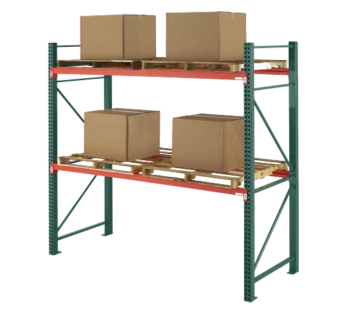Pallet Storage Racks
Okay, here is a lesson in pallet racking storage systems. Let’s call it “Pallet Rack 101”. Pallet storage racks for decades have been used in warehouses and distribution centers to store palletized products densely and affordably. Pallet rack consists of two primary components: Upright’s and beams. There is different terminology used across the country for … Continue reading Pallet Storage Racks
Okay, here is a lesson in pallet racking storage systems. Let’s call it “Pallet Rack 101”. Pallet storage racks for decades have been used in warehouses and distribution centers to store palletized products densely and affordably. Pallet rack consists of two primary components: Upright’s and beams. There is different terminology used across the country for these components but what it boils down to is upright’s are the vertical members and beams are the horizontal members that make up pallet racking. Depending on where in the country you are located, uprights are been called upright frames, columns and towers. Beams are called step beams, horizontals and crossbeams.
What is an upright? An upright is two columns or posts joined by horizontal and diagonal struts or bracing. The bracing is either welded or bolted to the upright columns creating what is called an upright frame. The upright frame is the vertical member of pallet rack that supports the beams.
There are many different brands and styles of uprights including the most popular “Teardrop Style”. Pallet rack uprights come in different height that range from 8′, 12′, 16′, 20′ and higher. Standard depths include 36″, 42″, 44″, 48″ and a max of 60″. They also come in different capacities ranging from 16,000 LBS, 20,000 LBS and 30,000 LBS capacity. Upright capacity can vary depending on how beams are spaced (more on that later). Uprights are typically vista green or royal blue in color.
What is a beam? Beams are the horizontal members that supports the pallet. There are two beams per shelf level, one in the front and one in the back. Beams are roll formed steel tubes with a standard 1-5/8″ step and end plated welded on the ends. The end plates have self-locking clips that keep beams engaged in the upright for safety. They come in many different lengths including 48″, 96″, 120″, 144″. They also come in many different capacities ranging from 3,000, 4,000, 5,000 and 6,000 lbs. per pair or per shelf level. Beams for pallet racking storage systems typically come in color safety orange.
There are basically 4 things you need to consider when determining what upright and beam is best for your application (And quite frankly we are here to help you figure this out. Just call us at 800-763-9020 and we would be happy to discuss it with you).
#1 Question when sizing up your pallet racking storage systems needs: What is optimum upright height? Your choices include 8′, 12′, 16′, 20′ and greater. Factors that affect upright height is how tall is your ceiling? How high will your forklift reach? How many pallets high do you want to store and how tall are your pallets?
#2: What is the optimum beam length? Again the choices include 48″ (storing one pallet wide, usually used to maximize and finish off a row of rack), 96″ (the most popular choice allowing you to store 2 standard size 40″ wide x 48″ deep pallets), 108″ (a good choice if you are storing 48″ wide x 48″ deep pallets), 120″ beams (typically used for storing items other than pallets) and 144″ length (which will allow you to store 3 pallets wide on a shelf).
#3: What is beam capacity required? To figure this out you want to multiply the pallet weight by the number of pallets per level. Which leads me to ask, what is the average weight of your pallet loads? Keep in mind that a beam capacity is based on a pair of beams. (Beam capacities range from 3,000, 4,000, 5,000 and 6,000 LBS or greater per pair of beams or per level).
#4: Maybe the most important question and one that is commonly overlooked is What is the spacing of your beam levels. When I teach classes on pallet racking storage systems I spend hours on the importance of determining what is the vertical spacing of beam levels. In other words, how many beam levels are where are the spaced in relation to the floor. For example, you could say you stack pallets on the floor and first beam level is at 60″, second and top beam level is at 120″. Beam levels are measured from floor to top of beam and top of beam to top of beam.
The reason that determining the number of beam levels and spacing of beam levels is so important is that it is the true determination of an uprights capacity. By that I mean an uprights listed capacity is based on 48″ beam spacing. If you increase the spacing of the beams to 60″ the capacity goes down. The farther the beams are spaced from one another (or greater distance between shelf levels), the lower the capacity of pallet racking storage systems.
For example if you purchase a 20′ x 42″ upright with 30,000 LBS capacity at 48″ beam spacing and you decide to use it to store your 8′ tall pallets and put the first beam level at 8′-6″ off the floor the 30,000 LBS capacity rating is downgraded to 8,000 LBS capacity. That is a big difference. AND IF THIS IS NOT TAKEN INTO CONSIDERATION YOU COULD HAVE A RACK FAILURE.
Another way of determining beam spacing and this may make it easier for you is to take the pallet load height + 6″ of lift off + height of beam face to get required spacing of beams. If you want to round that off just say pallet load height, measured from the floor to the top of your pallet load + 12″. This equation will tell you approximately what your beam spacing is. You will want to relay this information to your rack dealer. It will allow him to be more competitive in his quote and most importantly quote you the correct upright capacity to support your pallets.

